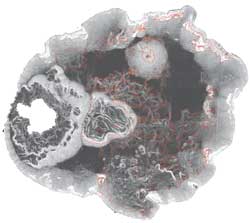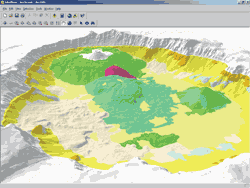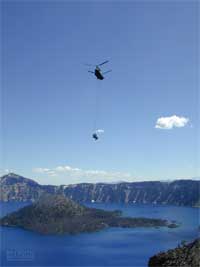ArcUser Online
The new survey, conducted over a five-day period in the summer of 2000, used Surf Surveyor, an eight-meter (26-foot) research vessel owned and operated by C&C Technologies, Inc., of Lafayette, Louisiana. Fire fighting demands made commercial helicopters unavailable so a U.S. Army Reserve Chinook CH-47D helicopter from Fort Lewis, Washington, lifted Surf Surveyor from a trailer at the caldera rim to the lake and back again. Data was captured using a Kongsberg Simrad EM1002 high-resolution multibeam echo sounder mounted on the hull of the vessel. It received the reflected sound that determines both the depth and strength of the signal (acoustic backscatter) as the vessel moves forward. Approximately 16 million soundings were recorded. Maximum lake depth was determined to be 594 meters (1,949 feet). This makes Crater Lake the deepest lake in the United States and the seventh deepest in the world. Flying Along the Lake BottomOn both PC and UNIX systems, the bathymetric data was visualized and analyzed. The applications used were ArcView with the ArcView 3D Analyst extension, the GRID module in ArcInfo, ArcGIS, and the ArcScene application in the ArcGIS 3D Analyst extension. A great deal of time was devoted to virtually flying around the imaged lake bottom studying the underwater terrain. Initially, this was done in ArcView 3D Analyst and later in ArcScene. With two-meter resolution data, the level of detail was truly stunning. These very positive first flights combined with information from lake bottom rock samples retrieved in the 1988 and 1989 missions of the manned submersible Deep Rover made it clear that GIS visualization could be used to map the underwater geology of Crater Lake. Compiling the Geologic MapThe geologic map was compiled by USGS geologist Charles R. Bacon. Bacon has studied the geology of the Crater Lake region for more than 20 years. Hillshade images with varying sun azimuths and illumination angles were created for viewing lake bottom features with different lighting. Geologic contacts were digitized and geologic features labeled with the hillshades serving as basemaps.
A slope map of the lake floor proved to be one of the best views for interrogating the bathymetric data. The slope map was generated in grayscale and shaded by percent slope. Areas with low slope percentages received dark color values while areas with high slope percentages received bright color values. This had the effect of highlighting changes in slope and was useful in delineating the edges of lava flows, landslide deposits, and ancient shorelines where lava from a vent that erupted above the water's surface flowed into the lake, shattered, and formed steep slopes of broken rock. A grayscale acoustic backscatter map was created from the strength-of-signal data recorded by Surf Surveyor. The type of geologic material present in a given area can be determined by the acoustic backscatter data. Solid lava flows and loosely consolidated sediments exhibit very different acoustic backscatter values. The acoustic backscatter map was also used as a base for geologic mapping. Cross sectional profiles of lake floor features were also generated with GIS. Because underwater features, such as volcanoes and landslides, commonly exhibit distinct ranges of slope values, the values determined for lake floor features at Crater Lake were compared to known values for underwater volcanoes and landslides that have been mapped in places such as Hawaii. Using this method allowed the features beneath the surface of Crater Lake to be characterized and identified. When the geologic map was complete, four separate volcanoes, two lava flow fields, and several landslides had been identified on the lake floor. Only one of these volcanoes, Wizard Island, actually rises above the water's surface. Most lava flows on the lake floor appear to have erupted entirely underwater, and the largest landslide, the Chaski Bay slide, covers an area of 4.56 square kilometers (2.83 square miles). Continued on page 2 |


